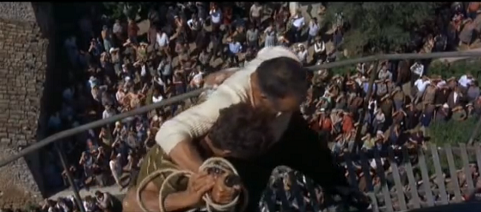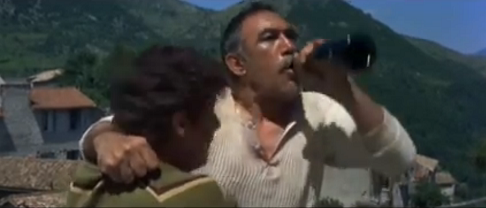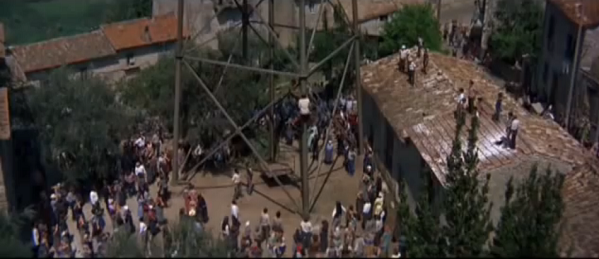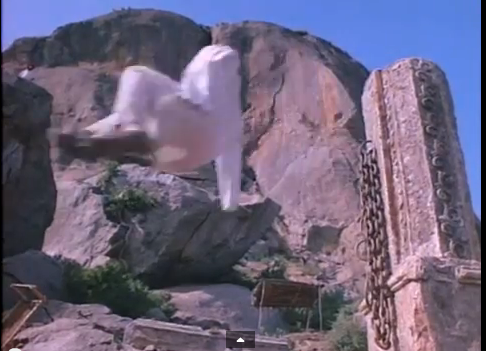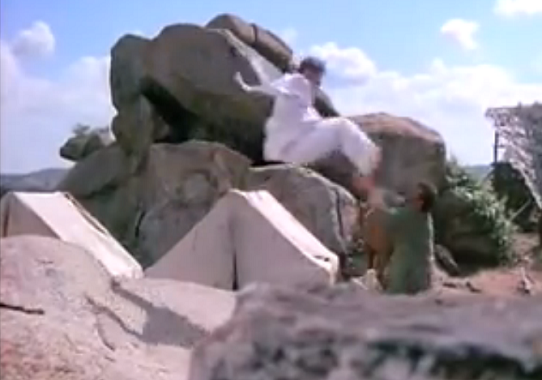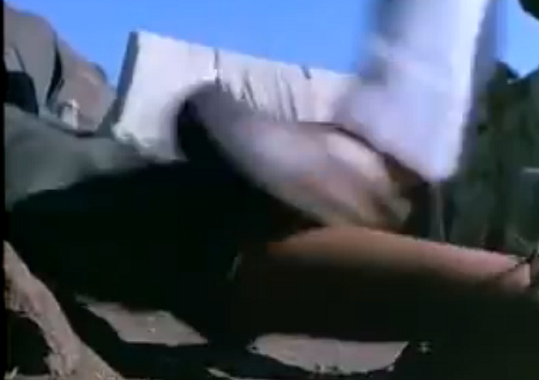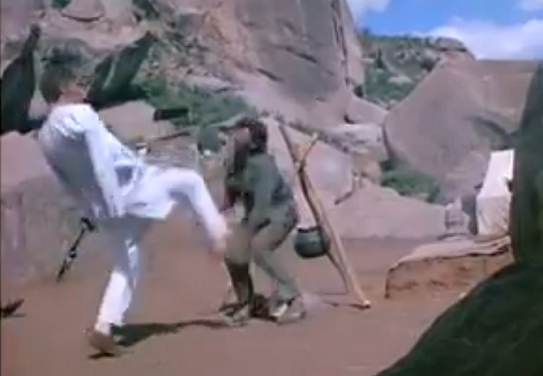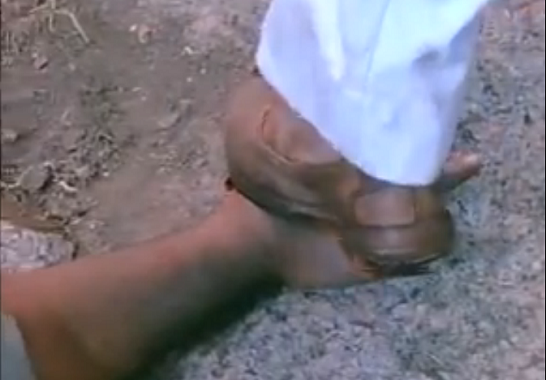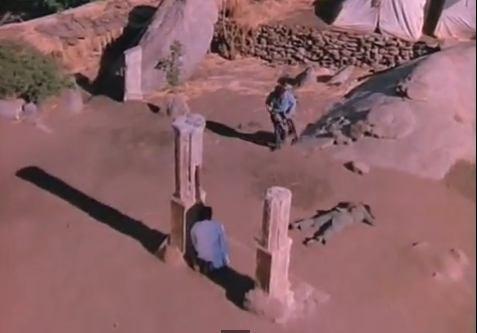Sholay
Crew
Director: Ramesh Sippy
Writers: Salim-Javed (Salim Khan, Javed Akhtar)
Produced by G.P. Sippy
Director of photography: Dwarka Divecha ...
Sound re-recording: Mangesh Desai ...
Film Editor: M.S. Shinde
Production Company: United Producers, Sippy Films
Label on which the soundtrack albums of the film were released: Polydor.
(The soundtrack of India's first stereophonic film Around the World were released in Mono. Sholay's stereophonic songs boosted the sales of stereo systems and were used as demonstration discs at shops that sold audio systems. The film's dialogues became so popular that hundreds of thousands of Indians wanted to own a piece of the film itself. There were no video discs or tapes in 1975. So, Music India Limited brought out an album, also in stereo, of selected dialogues from the film on the Polydor label. It was a superhit for years. HMV responded by issuing Kabhi Kabhie's dialogues on black disc.)
Cast
Dharmendra: Veeru
Sanjeev Kumar: Thakur Baldev Singh
Hema Malini : Basanti
Amitabh Bachchan : Jai
Jaya Bhaduri: Radha
Amjad Khan : Gabbar Singh
A.K. Hangal : Imam Saheb
Satyen Kappu : Ramlal
Iftekhar : Narmala ji (Radha's father)
Leela Mishra : Mausi
Vikas Anand: Jailor
Mac Mohan: Saamba
Keshto Mukherjee: Hariram
SachinV Ahmed
Master Alankar Joshi: Deepak
Viju Khote: Kaalia
Major Anand and Bihari: The two dacoits whom Gabbar kills because they were funks (jo dar gaya)
Asrani: The 'British-era Jailor'
Gita Siddharth: Deepak's mother
Helen: ‘Mehbooba,’ the gypsy dancer
P. Jairaj: Police chief
Jagdeep: Soorma Bhopali
Jalal Agha: The one who sings ‘Mahbooba’
Om Shivpuri: Inspector Saheb
Sharad Kumar: Ninni
Technical Specifications
Runtime: 188 min/3:08 hrs (version released in 1975); 204 minutes/ 3:24 hours (3D version released in 2014).
Sound Mix: 6-Track stereophonic (on 70 mm prints)| Mono (on 35 mm prints)|
Color: EastmanColor
Aspect Ratio: 1.37 : 1 (original negative) / 2.20 : 1 (70 mm prints)
Country: India
Language: Hindi
Release Date: 15 August 1975 (India)
Outdoor shooting at: ‘Sippyvaram’/ Ramnagram village on the Mysore-Bangalore highway, Karnataka, India
The greatest story ever poached
Plagiarism— to but also from
Sholay's tagline was 'The greatest star cast ever assembled/ The greatest story ever told.' Instead, it should have been 'The greatest story ever assembled,' because writers Salim-Javed drew 'inspiration' from more than half-a-dozen sources
Mera Gaon Mera Desh (dir: Raj Khosla/ 1971), a super hit, was the last major dacoit film before Sholay. Many critics have pointed out that it inspired Sholay's basic theme. In MGMD the one-armed Havaldar-Major Jaswant Singh reforms a small-time thief, Ajit (played by Dharmendra, who also acts in Sholay) and persuades him to defend his, Jaswant's, village against dacoits.
What Salim-Javed did was to chop off both of Jaswant's arms, make that chopping-off the fulcrum of the story, and expand Jaswant into a tragic hero of epic proportions. The makers of Sholay must have seen MGMD because in the latter film the dacoit played by Vinod Khanna is called, guess what?, Jabbar Singh.
MGMD's initial story is eerily similar. After Ajit completes his jail term (in Sholay: after Jai and Veeru do), the jailor tells him (in Sholay: them) that Jaswant Singh will give him (them) a job in his, Jaswant's, village. Because Sholay was of epic proportions, the Havaldar-Major (Sergeant-Major) gets blown up into Superintendent of Police (Colonel). In MGMD Jai falls in love with a local belle, Anju. In Sholay this lady gets transformed into the unforgettable Basanti. Both villages have a mausi and both films a drunkard or two.
The dacoit's moll in MGMD has a fully developed role with the film's most popular songs. In Sholay, however, she gets reduced to a non-speaking appearance in the film's most popular song.
Sholay’s classic scene in which we first see Gabbar is inspired by the following scene of MGMD: [[1]] (4:03 onwards) In MGMD Thakur Jabbar Singh lines up all the people he suspects of having betrayed him and strides past them one by one, much like Gabbar does with the men who let him down. Jabbar informs his men that he is putting only one bullet in his double-barrelled gun. Jabbar keeps only three bullets in his six-bullet revolver.
Soorma Bhopali: Author Anupama Chopra who wrote the definitive book, Sholay – The Making of a Classic, argues that the Soorma Bhopali character is based on a servant in Madhumati (dir: Bimal Roy/ 1958) whose bragging is found out by his employer.
The coin with two obverses: Imdb.com quotes one of the film's writers Salim Khan as saying that Jai's coin-flipping habit was adapted from Garden of Evil (1954/ Henry Hathaway). In that film, Gary Cooper and Richard Widmark drew cards to decide who would leave and who would stay behind to fight the Apaches. The 'sleepy little Mexican village' is replaced by India's own rockies, but Sholay's theme about brave mercenaries being induced to go to a village on a noble but lucrative mission (rescuing a man trapped inside a gold mine) is not very dissimilar.
That the song Mehbooba, O Mehbooba used Demis Roussos’ Say You Love Me as its starting point is beyond debate. However, RD’s is an energetic, masculine, fully-fleshed out version of Roussos’ tentative, almost timid original, and has a lustier, more confident instrumentation to boot. Still, a copy is a copy. The YouTube link [2] neatly superimposes the Say You Love Me track on the Gabbar (Amjad)-Jalal Agha-Helen video.
Many critics tell us that Sholay’s basic premise (hired guns wind up doing a great and even selfless and noble job) was taken from The Magnificent Seven. The same critics always hasten to add that the latter, in turn, ‘had been inspired by Akira Kurosawa’s Seven Samurai. ’ The fact is that Sholay’s basic premise is not ‘hired gun’ as much as ‘hired former con.' Therefore, this argument is ill-founded.
Veeru’s drunken histrionics atop a water tank were a brilliantly Indianised version of an almost identically shot sequence in Stanley Kramer’s The Secret of Santa Vittoria (1969) Full movie/ Relevant excerpt. The sequence was, without doubt, inspired but it was not plagiarised—because the ‘why do the Englsih commit suicide?’ and ‘Aunty jail going, aunty chakki peesing’ dialogues were classic Salim-Javed originals. (However, the mausi's initial sarcastic comments when Veeru is up there on the water tank, with his bottle of alcohol, have indeed been 'inspired' by Santa Vittoria.)
It is the mausi sequence that merits a doctoral dissertation---one that leaps across five continents, six of the proverbial seven seas and several decades, if not more. That Salim-Javed did NOT write this scene is also beyond debate. The mystery is about the source from which they stole the scene.
Deepak Mahaan informs us in The Hindu that Kalidas’ Half Ticket (1962) had ‘a scene plagiarised by Salim-Javed for “Sholay” wherein Amitabh pitches for his friend's matrimony with “Mausi” (Leela Mishra) with [the] same absurd logic.’
However, Vivek Kaul points out in FirstPost that 'The entire Veeru ki Shaadi scene is copied from’ Khaufnak Imarat (The House of Fear/ Urdu/ 1955) written by the great Ibn-e-Safi.
People who grew up in West Punjab before 1947 and who had certainly not seen Half Ticket (and are unlikely to have read Khaufnak Imarat ) knew a story with specious arguments similar to Jai’s, in which he pretends to exculpate his alcoholic friend Veeru, but actually makes sure that the bride's mother gets to know his friend's faults. Could the mausi story, then, be part of traditional North Indian folklore? Or did it enter the folklore of the Punjab because of Khaufnak Imarat ?
The question is: how did this scene find its way into writer-director Oliver Stone’s Salvador (1986/ UK/ USA)? That Mr Stone is not the real author of this scene is equally beyond debate. By the time he started making his film Sholay had been screened in theatres in the USA and UK. The author of this article saw Sholay on British television in 1987, and that did not seem to have been its UK TV premiere. Did Mr Stone pick that sequence up from Sholay and westernised (Hispanicised, actually) it somewhat? Or were that set of seemingly friendly arguments part of Salvadorean folklore, too, just as they were part of Punjabi folklore? In that case, did the story travel from India to El Salvador, or did identical funny arguments pop up in the human brain across continents?
The greatest star cast ever assembled
When Sippy started shooting Sholay, Dharmendra was India's highest paid filmstar, and Hema Malini the no.1 actress in terms of commercial success. However, by the time it was released Dharmendra had slipped to no.2, and Amitabh Bachchan was the reigning no.1. Sholay had all three in its cast.
Sanjeev Kumar was considered the best actor of that era and Jaya Bhaduri the best actress, though their commercial ranking was somewhat lower—only somewhat. Bhaduri’s Zanjeer had been the no.2 hit of 1973 and her Jawaani Diwani ranked at no. 8 among the commercial hits of 1972. Sanjeev had been one of the two male leads of Seeta aur Geeta, the no. 1 success of 1972.
Each of these five had helmed major Filmistan productions and received top billing in those films.
Among the biggest commercial successes to the credit of Dharmendra, Hema Malini and Sanjeev Kumar was Seeta Aur Geeta, the no. 1 hit of 1972. It, too, had been written by Salim-Javed and directed by Ramesh Sippy. Sholay repeated the winning team--and augmented it.
Sachin Pilgaonkar, who acted as Ahmed, a minor character in Sholay, went on to play the leading man in Geet Gaata Chal (1980) and Nadiya Ke Paar (the no. 19 hit of 1982), both of which did extremely well at the box office, especially in relation to their small budgets.
And yet the actor most responsible for Sholay's historic success was the thitherto unknown Amjad Khan (born 1940). Because his father Jayant and brother Imtiaz were established Filmistan actors--albeit character actors--Amjad had been acting in films since age 11, and as an adult had done bit roles in two films before Sholay. He was 35 when Sholay released and, with five film and several theatre roles to his credit, hardly a greenhorn.
Filmistan recognised Amjad's contribution and for the next seventeen years (Khan died in 1992) he was a superstar among character actors.
And yet, Filmistan also believed that a major cause of Sholay's mammoth success was its huge star cast--rather than an exceptionally crafted script, good direction and impeccably -fleshed out characters. This led to the beginning of the trend of 'Multi-star' Hindi-Urdu films. There had been multi-star films before, but Sholay started the trend; just as there had been Cinemascope as well as 70mm films before but Sholay made India wake up to the widescreen.
Censored/ deleted sequences
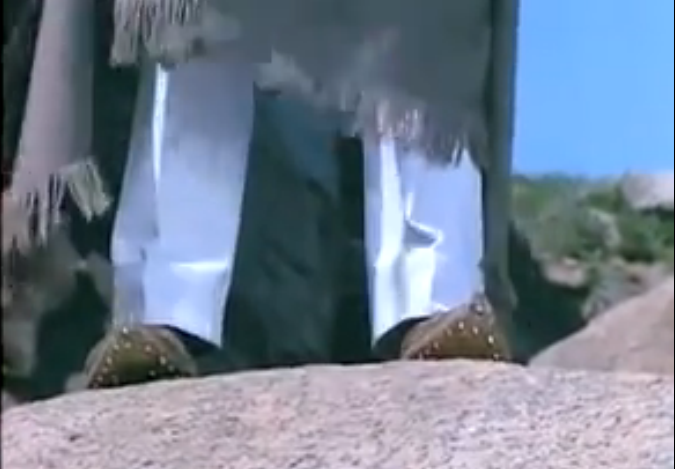
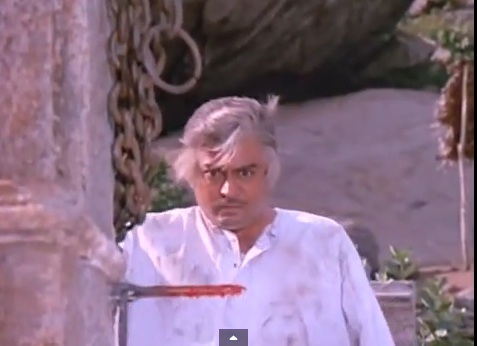
Sholay was released just six or seven weeks after 'a state of emergency' was declared on India. This included, for the first and last time in the history of independent India, press censorship. A squeaky clean family film like Sholay ought to have had nothing to worry about from the pre-June 1975 film censors of India.
However, the Emergency censors decided that even violence of the kind normal in Disney cowboy films was too much for India's gentle audiences. No film could have more than six minutes of violence and no 'violent' sequence could last more than a minute. Fisticuffs had, in the early 1970s,been the mainstay of India's commercial films, in Hindi-Urdu as well as Tamil and Telugu.
Because of the Emergency, most commercial filmmakers opted for scripts that had a quota of six one-minute sequences per film-more was out of question because of the censors, and less was not acceptable to mass audiences. Some films (e.g. Khoon Pasina) want to show more action than that. So,they awarded themselves additional action scenes in which the two antagonists (normally the hero and the villain) chased each other, lunged towards each other, wielded lathis (long batons) but did not actually touch each other in sequences that exceeded the six-minute quota.
By the time Sholay was released the six-minute quota had not been imposed. But the censors deleted three sequences, the last of which was critical to the story. In it the Thakur, whose arms had been chopped off by Gabbar, the villain, decides to kill Gabbar with his feet--with little metal spikes studded on the soles of his shoes.The spiked-shoe climax, 7.11 minutes The censors got this sequence replaced by one in which the police arrives in the proverbial 'nick of time' and takes Gabbar into custody.
Because this sequence was deleted, a shorter sequence in which a village cobbler studs the Thakur's shoes with metal spikes, became meaningless. The film's makers deleted it on their own.
A third sequence that shows how Gabbar kills young Ahmed (Sachin), too, was chopped off by the censors.Ahmed’s murder: 2.48 minutes
Since the early years of the 2st century, unauthorised DVDs crafted by Indians living in the West have been available in which the sixteen deleted minutes have been added where Salim-Javed and Ramesh Sippy had intended them to be. Most of those 16 minutes are also available on YouTube.
In 2014, a 3D version of Sholay was released with the previously deleted 16 minutes. Sholay 3D (2014)
B: Secret British stuntmen, Amjad's salary
August 6, 2025: Hindustan Times
Amjad, who later became a household name thanks to Gabbar, was paid just ₹10,000 for his role. The director, in a tribute to Amjad following his death in 1992, revealed that initially the actor, who was facing the camera for the first time, showed nervousness, especially doing action scenes.
Amjad had to deliver his lines while riding a horse and also rub his tobacco in his palm; it proved difficult for him to coordinate the two. Several 'takes' were needed to get the scenes right. Halfway through, his crew members suggested that Amjad be dropped and a more experienced actor like Pran or Prem Chopra be brought in. But Ramesh Sippy had faith that Amjad would rise to the occasion, and the rest is history.
Critics gave mixed reviews upon release
When Sholay was released in October 1975 all over India, some critics dismissed it as a pastiche, taking inspiration from The Great Dictator, Once Upon a Time in the West, The Magnificent Seven, and even Mera Gaon Mera Desh. Director Ramesh Sippy and his scriptwriters, Salim and Javed Akhtar, went on to admit that their ideas for Gabbar Singh were derived from Eli Wallach's portrayal in The Magnificent Seven.
The men behind the action
For many years, the Sippys, both producer G. P. Sippy and his director son Ramesh, kept the involvement of British technicians in the making of Sholay a closely guarded secret. Their names are not mentioned in the credits. The reason for their secrecy was twofold. Many of the top technicians were paid in hard currency, and secondly, the Indian film unions, the cameramen's and stuntmen's, objected to the foreigners' names in the film's credits.
Sholay's bravura action sequences were conceived and executed not by Ramesh Sippy but by two British horse experts and stunt coordinators, Jim Allen and Jerry Crampton. Allen was the second unit director in Sergio Leone's spaghetti westerns and has also worked in How the West Was Won. The train attack sequence and most of the daring action sequences with horses were the handiwork of second unit director Jim Allen and stunt coordinator Crampton (who was responsible for stunt sequences of Attenborough's Gandhi).
The initial train attack sequence took two months of hard work to shoot, and the three British stuntmen who doubled for the dacoits were paid ₹50,000 each plus life insurance for jumping off a 40-mph running goods train and doing triple somersaults after falling on the ground.
Interesting facts
A
1. Dharmendra's portrayal of Veeru was impressive. However, the actor was initially keen to play the role of Thakur Baldev Singh in the film. According to IMDb, if Dharmendra had played Thakur then Sanjeev Kumar would have played the role of Veeru and get to romance Hema Malini. Apparently, Sanjeev Kumar had proposed marriage to Hema Malini at the time. Allegedly, Dharmendra, too, was in love with her. Seems like Dharmendra did not want to lose out on an opportunity to romance Hema and hence, finally agreed to play Veeru. Five years later, in 1980, Dharmendra tied the knot with Hema Malini.
2. Amjad Khan played a very convincing villain, Gabbar Singh. Apparently, if destiny hadn’t played its part, Amjad Khan may not have landed the role at all. According to a report on Movies.ndtv.com, Danny Denzongpa was the first choice to portray the villainous character. However, Danny had to drop out of the film as he was shooting for Feroz Khan'sDharmatma in Afghanistan. The report further stated that scriptwriter, Javed Akhtar, was not very convinced with Amjad Khan’s casting as he had felt that his voice was too weak for him to work as a villain.
3. Sholay starred some of the best names from the industry. Apparently, Amitabh Bachchan was not the original choice for the film. Shatrughan Sinha was initially shortlisted to play Jai in the film. However, according to IMDb, Amitabh Bachchan managed to convince the producers that he was suitable for the role. During the climax scene of the film, Big B and Dharmendra have an elaborate action sequence. Apparently, it was a narrow escape for Amitabh Bachchan, who ducked a stray bullet, fired by Dharmendra.
4. The most feared villain, Gabbar Singh, was supposed to be killed by Thakur in the original climax of the film, Sholay. According to a report, Sanjeev Kumar was supposed to kill Gabbar despite his disability in the film. This was how the scene was shot as well, but apparently the Censor Board did not agree with the film’s climax. The Board suggested that the criminal be arrested by the police and not killed by the respected Thakur, so as to set an example. Hence the film's climax was later changed.
5. The comedy scene in Sholay, where Amitabh Bachchan meets Basanti's mother, to talk about his friend, Veeru's marriage, has been inspired by a real-life incident. The inspiration for the scene was a conversation between Sholay's writer, Salim Khan, and Honey Irani's mother. Apparently, Salim was batting for Javed Akhtar, in the same manner as Amitabh does for Dharmendra in the film. Honey Irani and Javed Akhtar tied the knot later. The scene was also influenced by a scene from Kishore Kumar's Half Ticket, where he talks ill about himself to scare off a pandit.
6. Despite Sholay being a very popular movie, it had low attendance in theatres. It was about to be removed from cinemas because of its poor performance, but things changed with a positive word-of-mouth. The film then ran in cinemas for years. Apparently, Sholay was the first first film in the history of Indian cinema to celebrate a silver jubilee run in about 100 theatres across India.
Songs
All lyrics by Anand Bakshi
All music credited to Rahul Dev Burman, including a song not quite composed by him.
Holi Ke Din Sung byKishore Kumar & Lata Mangeshkar
Jab Tak Hain Jaan Sung byLata Mangeshkar
Koi Haseena Sung byKishore Kumar
Mehbooba O Mehbooba Sung byRahul Dev Burman (based on Demis Roussos’ Say you love me)
Sholay Title Theme
Yeh Dosti (happy version) sung by Kishore Kumar & Manna Dey
Yeh Dosti (Sad Version) Sung by Kishore Kumar
"Chaand Sa Koi Chehra": the song not used in Sholay
In addition, a qawwali, "Chaand Sa Koi Chehra," had been recorded for the film (and sung by Kishore Kumar, Manna Dey, Bhupendra Singh and, above all, lyricist Anand Bakshi) but never used. In the film it was supposed to be sung by Jai, Veeru and fellow inmates during their stint in jail. The song was never shot because it would have added to the already considerable length of the film, director Ramesh Sippy told an online channel. G9 Premiers, on which you can hear roughly 40 seconds, from 2.00 to 2.40. You can hear 5:49 minutes (i.e. almost the entire song) juxtaposed quite cleverly on a 'fake' video [3]. The lip--synching is nowhere near perfect, but still quite good. The 'fake' video is a qawwali filmed on Dharmendra and Amitabh Bachchan in the 1977 film Charandas.
The Karnataka area where Sholay was shot
Ramadevarabetta or Ramgiri Hills
The Times of India, Aug 09 2015
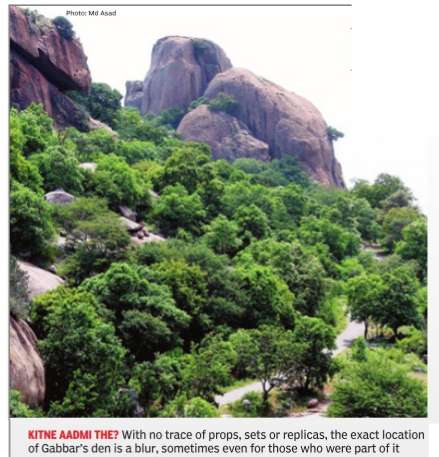
Jayanth Kodkani
The area now has trekkers, cyclists, occasional fans and vultures, but hardly anything other than the rocky backdrop reminds us of the movie
It was just over 40 years ago that Ramesh Sippy set his trailblazing film in the locale near Ramanagaram, 50 km southwest of Bangalore.The town is now a district headquar ter and popularly known as Silk City.
A 2 km-drive off the main road gets you to Ramadevarabetta or Ramgiri Hills or Sholay Hills. In the years that have rolled on, he neighbourhood has had a colony for the Iruliga tribe, a government school, and some other small structures. But perhaps the biggest change since has been the fencing of the land around Ramadevarabetta. It was done to declare an area of 346.14 hectares around as a vulture sanctuary, the country's irst, on January 31, 2012. Many plans were devised since the movie became a runaway suc cess: A Sippynagar showcasing the movie, a resort that celebrates its legend and even a tourist destina tion that recreates the magic, but nothing has happened on ground.
Hiking and biking clubs, though, have gone on to make it a cool desti nation. Anil Kadsur, who organizes rides to the hills, says, “Riding 100km (to and fro) and climbing the 400-odd steps helps us unwind.“ After riding up to the foothills, cyclists climb the steep stone steps to reach the temple and a little pond.
“The view of the Bengaluru-Mysu ru state highway from there is breathtaking,“ he says.
Art of Bicycle Trips (ABT) offers two rides in and around Ramanagaram. They also have a ride named after David Lean's, A Passage to India, based on EM Forster's novel.Some scenes of Lean's film were shot at Ramadevarabetta and the adjoining Sawandurga hills in 1983.
Yet it is the granite boulders on Sholay Hills that will live on. Believed to be among the oldest in history , geologists know the stone here as Closepet Granite. Closepet itself was named after Sir Barry Close (1756-1813), an army general in the East India Company . The place was later called Ramanagaram.
These sweeping vistas of history have passed on to scenes on celluloid.Even if there's nothing else to show that Sholay was made here, the hush around the hills will remain part of that memory .- With inputs by Charan CS and Aparajita Ray
Gabbar den was in a sanctuary for vultures
BV Shivashankar| 3D `Sholay' tour to skip Gabbar den | May 02 2017 : The Times of India (Delhi)
When the Karnataka government begins its “virtual 3D“ Sholay tour in Ramanagara district, where the iconic 1975 movie was shot, the itinerary will not include the den of its villain Gabbar Singh.
The location where the villain's lair was set falls under a sanctuary for vultures, a critically endangered bird, and the forest department had objected to its inclusion in the tour.
Karnataka's tourism department had initially proposed to conduct the tour in an area spread across 42,184sqft around Ramadevara Betta, where the fictitious Ramgadh was set up by Ra mesh Sippy . “The idea is to recreate the experience of `Sholay' where the movie was shot. But a part of this region is in a vulture sanctuary. So, we have decided to exclude Gabbar Singh's den from the virtual village,“ tourism minister Priyank Kharge told TOI on Monday .
Forest officials, however, are wary of the project, saying all the sites where the movie was filmed were also protected zones. Karnataka principal chief conservator of forests K S Sugara said, “There's no question of allowing the so-called Sholay village project in the forest area in Ramanagara...“
A curry western?
'Curry western' films are a genre that has existed in India since at least the early 1960s. They are an imitation of Hollywood's 'western' films. The characters wear cowboy hats and jeans.
India's Dacoit films in Hindi-Urdu, on the other hand, owe their origin to Jis desh mein Ganga behti hai (1961) and to the dacoits of Chambal (MP), who have been around since the British disbanded the armies of Indian states in the 1800s. Thus, the 'dacoit film' genre is, arguably, entirely indigenous. Evidence to the contrary will be welcomed.
In any case, these are two separate genres, though they might have horses and a dry, treeless, rocky terrain in common.
Sholay was a dacoit film and definitely not a 'western,' curry or otherwise.
Even if it is accepted that India's dacoit genre is totally indigenous and that Sholay is a dacoit film and not a curry western it does not mean that the film was not influenced by both BBQ- and spaghetti- westerns (as well as Indian and international films belonging to other genres.) The music used during some of the horse riding sequences is derived from the country & western genre and the treatment of those sequences clearly has a 'western' inspiration. Gabbar Singh's bar-be-cue, too, hints at that.
Initial response in 1975
The Times of India, Aug 09 2015
Avijit Ghosh
Sholay wasn't rated as an unquestionable masterpiece when it was released on August 15, 1975. In fact, the film was almost uniformly panned by the critics. Few films are tattooed on India's collective consciousness like Sholay, which turns 40 later this week. Director RameshSippy's blockbuster is often described as “Bollywood's greatest movie.“ But in his full-frontal memoir, And Then One Day , actor Naseeruddin Shah has a contrarian take. Over almost three pages, the actor rips into Sholay, deeming it unworthy of its iconic status. To many Indians, that might be like saying: Tendulkar is not a batting great. “I could identify the source of al most every single scene -not only Spaghetti classics, even Mr Chaplin was not spared,“ Shah wrote. “The action scenes were competent but by no means breathtaking, I had seen stunts of surpassing excellence in many a second-grade Hollywood Western... While I do not dismiss for a moment the effort and time that went into it, I bristle every time it is included among the great Indian movies.“
`Just Another Dacoit Tale'
It's possible to argue that Shah was deliberately playing agent provocateur and his note of dissent is in consonance with the largely dismissive tone of his critique of mainstream Bombay cinema, including his own work. But travelling back to 1975, if you re-read the reviews for Sholay in three national newspapers and one popular weekly magazine, you discover that Shah's view is closer to that of the critics. The reviewers do laud the film's technical excellence but none, even remotely , give the impression of having watched a movie that could be hailed as a masterpiece. The Illustrated Weekly of India (now defunct), a sister publication of The Times of India, said in the August 31, 1975 issue: “There is nothing in the script of Salim-Javed to make this `the greatest story ever told,' it is just another dacoit tale on the lines of Mujhe Jeene Do, Gunga Jumna, Mera Gaon Mera Desh... The stereophonic sound and other technical innovations redeem Sholay from the shallows.Ramesh Sippy has introduced a feeling of verve and some of the action is gripping. But no sooner you are out of the theatre, it is gone: you realize that a story built on negative emotions like hatred and violence can have no lasting impression on the mind... Where the film fails is in its music -there is not one song that can be singled out as a noteworthy composition.“
Sunday Standard, incorporating the Sunday Indian Express, too was underwhelmed. In its review headlined, “Yet another dacoit film with Hollywood touch“, the film critic wrote in its Delhi edition: “In their desperate search for new material, the manufacturers of Bombay's dacoit series have by now scraped everything of the barrel. And so what SalimJaved sit down to do is the painstaking job of reassembling the parts, strictly to suit the individual talents of the `greatest star cast ever assembled' all of which (Butch Cassidy and the Sundance Kid, Bad Day at Black Rock, Bonnie and Clyde, Secret of Santa Vittoria, etc) add up to a shaggy dog Western, sporadically funny , ludicrously heroic, monstrously violent and sprawled in loose limbed abandon.“
Violence Extravaganza
In the 1970s, Indian films were often questioned for excessive violence, nudity and sex. The Hindustan Times review raised moral questions about the glorification of violence in the film: “Its technical virtues apart...Sholay's plot is laden with moral snapping implications. Which police officer or, for that matter, judge will not get cold feet in dealing with or sentencing a dangerous criminal after seeing the plight of Sanjeev Kumar in this film? Sholay manages to raise screen violence to almost unimaginable heights. And thanks to our censors, children may relish it too.“
Endless Assault
The Statesman's (Delhi edition) review began with the line: “If I were asked to sum up this film in one word, the word would be `endless'. For nearly 4 hours this film assaults one's senses psychologically, emotionally and at the end almost physically . One comes out of the cinema drained, exhausted.“ Ironically , the movie got its lone Filmfare award (1976) for best editing (MS Shinde).
“Technically, this films achieves the kind of splendour that is comparable to standards anywhere in the world,“ the critics wrote, but also pointed out, “Thematically, it is an exercise that verges between the two peaks of inanity and insanity .“
A Classic's Tale
What these lukewarm reviews clearly reveal is that Sholay acquired its iconic status in Indian cinema over the years.
[Indpaedia adds: Over the weeks, actually. It might not have been that big in the first week or two but within the first month, the film was huge. There was a demand for a disc of its dialogues: which Polydor India promptly met. The soundtrack album of India's first 70mm film, Around the World, was not stereo. Sholay was. All music shops had Sholay's music blaring from its stereo players. In medium cities like Jammu, where no film was ever screened at two cinemas at the same time (and remained so till the digital projection revolution of around 2010) Sholay's sole print was shuttled between two halls within the first month.]
Forget popular online polls, the film is now ranked among the finest of Bollywood even in serious cinema discussions. By and large, the movie has won over its critics prompting a reassessment of sorts. In 2005, Filmfare Awards called it The Best Film of 50 Years. Considering that “the greatest story ever told“ lost out -along with Aandhi, Amanush and Sanyasi -to Deewar for the Best Film when first released, that is quite a post-script.
No shabashi for Gabbar
For most Bollywood buffs, Gabbar Singh is the greatest baddie ever. Loin, Mogambo, Shakaal, Dr Dang...nobody comes close. Even four decades later, every dialogue spoken by the tobacco-chewing killer -Arre o Sambha, Kitne aadmi thhey, Tera kya hoga Kaalia is remembered and repeated.
Yet ironically, the reviews of the time did not have a single word on Amjad Khan's performance.The Illustrated Weekly of India was the only one to praise Khan's “impressive debut“ but went on to remark that “he is not gifted with the fine voice his father Jayant had.“
Interestingly, Naseeruddin Shah in his book writes that following the film's sub-par box-office performance in the first few days of its release, “a convenient scapegoat was found: the newcomer who had played Gabbar Singh the dacoit, in a manner the audiences were unfamiliar with.“ The now much-loved Gabbar didn't even bag an award since there was no `Best Villain' category in the Filmfare Awards those days. Amjad Khan was nominated in the Best Supporting Actor category but the award went to Shashi Kapoor (Mere paas maa hai) for his performance in Deewar. -Avijit Ghosh
Tera kya hoga, Viju Khote?
The Times of India, Aug 15 2015
Avijit Ghosh
40 yrs on, Kaalia recalls his tryst with `Sholay'
During the film's shooting on the outskirts of Bangalore, the unruly horse he was riding threw him down at least six times. For all the pain, literally in this case, he received a mere Rs 2,500 as fees. But for actor Viju Khote, the consolation and triumph is that even 40 years after Sholay first hit the silver screen on August 15, 1975, nobody has forgotten Kaalia, the character he played. Khote had only two scenes in director Ramesh Sippy's three-and-a-half hour action saga. First, when Kaalia and two other dacoits visit Ramgarh to collect foodgrain for Gabbar's (Amjad Khan) gang. Kaalia hurls abuses at the miserable villagers and trades barbs with Thakur (Sanjeev Kumar). Two of his wisecracks are: “Aao Thakur aao, abhi tak zinda ho“ and “Suno, Thakur ne hijron ki fauj banayee hai.“
Second, when Kaalia and his colleagues return emptyhanded to Gabbar's den. In the long-drawn scene that follows, Amjad Khan mouths the famous dialogue, `Tera kya hoga Kaalia', that has since become Khote's calling card. Millions across India still remember most one-liners of the blockbuster. But `Tera kya hoga Kaalia' along with `Arre o Sambha' and `Kitne Aadmi Thhey' prompt top recall. “For many years after the film's release, people on the road would rec ognize me and repeat what Amjad had told me: Tera kya hoga Kaalia,“ he told TOI over the phone.
The character actor himself had only one line in that iconic scene which introduc es Gabbar to the audience. It was, “Sss sardar, maine aapka namak khaya, sardaar,“ to which the dacoit leader replies, “Ab goli khaa.“
Khote, now 73, admits to enjoying the recognition as part of an actor's life. “It signifies the tremendous popularity of the movie. And that people liked Kaalia as a character,“ the actor says.
He recalls shooting about 10 days in early 1973 for the multi-starrer. His most abiding memory is being constantly thrown off the racehorse. Luckily , he did not break any bones. “Those days the muscles were harder,“ jokes the younger brother of actor Shubha Khote.
The character-actor stayed in touch with Amjad Khan after Sholay . “Actually I had done a play with him before the movie. The play , To this night a dawn, was directed by his brother Imtiaz. After Sholay, I did four-five more films with him. But I don't remem ber their names,“ he says. Records show some of them are: Laawaris, Charas, Yaarana and Plot no 5.
Khote, who was last seen in the just-released movie, Gaur Hari Daastan, has acted in nearly 300 films and 30 teleserials. He doesn't remember most of his roles barring Robert in Andaz Apna Apna where he delivered the funny but slightly asinine line, `Galti se mistake ho gaya'.
No character has stayed alive in popular imagination like Kaalia though. In fact, in Ajay Devgn's Atithi Tum Kab Jaoge (2010), Khote played Kaalia again. In the film, he is pestered by a mischievous Paresh Rawal who confronts him with the persistent query: Kitne Aadmi Thhey .
See also
The page 70mm films in India/ South Asia, among other things, has two photographs that show how Sholay was blown up from 35mm to 70mm.
